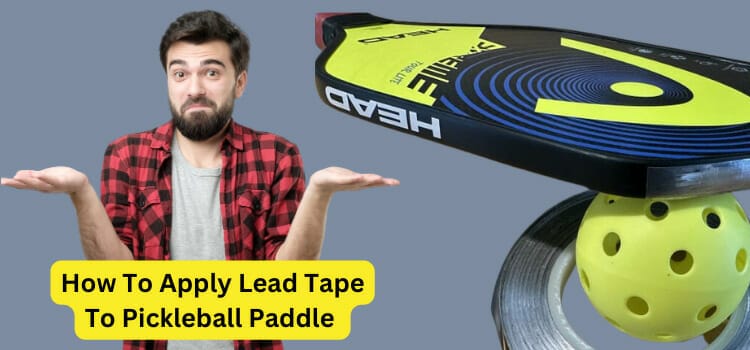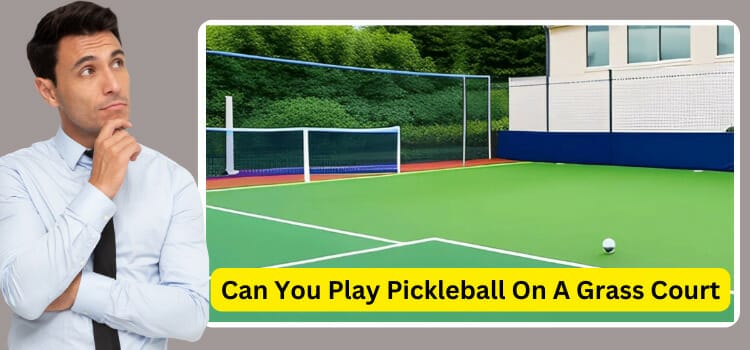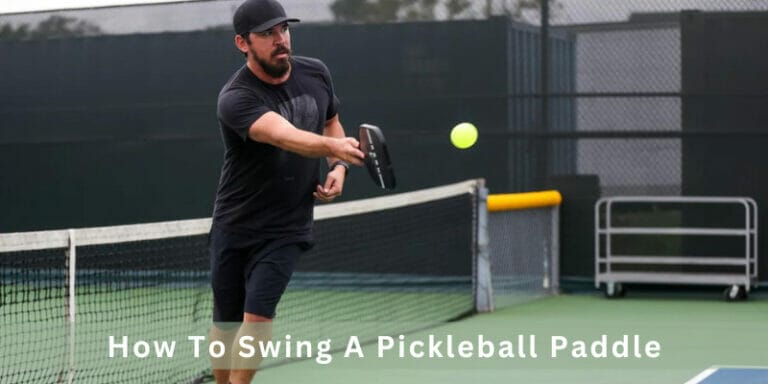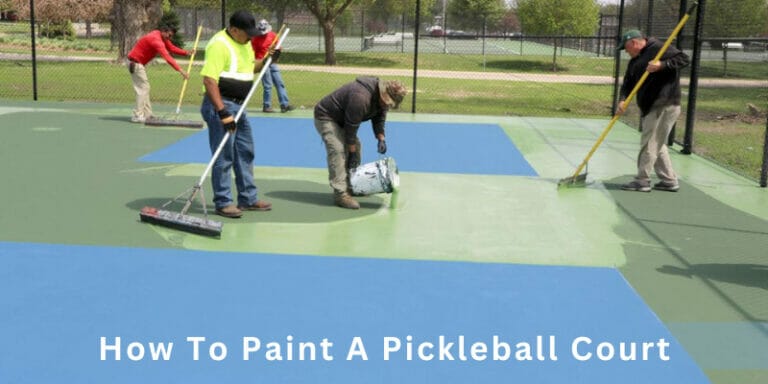How To Apply Lead Tape To Pickleball Paddle: Unleash Your Game

Adding lead tape to your pickleball paddle can make a world of difference in your performance. But how To Apply Lead Tape To Pickleball Paddle? Don’t worry – we’ve got all the answers for you right here.
To apply lead tape to a pickleball paddle, clean the surface, measure and cut the tape, peel off the backing, and strategically place it on the paddle. Press firmly, smooth out any bubbles, and trim excess tape for a neat finish.
Here I’ll walk you through step-by-step instructions on how to apply lead tape to your pickleball paddle like a pro. Whether you’re a seasoned player or just starting out, this guide will help take your skills to new heights. So let’s dive in and get ready to ace that next match!
How do you put tape on a pickleball paddle? Step-by-Step-guide
Applying lead tape to a pickleball paddle is a straightforward process that involves the following steps:
- Prepare the Paddle: Start by ensuring that the surface of your pickleball paddle is clean and dry. Remove any dirt or moisture, as it can interfere with the tape’s adhesive and prevent it from sticking properly.
- Cut the Tape: Determine the amount of weight you want to add to your paddle. Cut the lead tape to the desired length using scissors or a craft knife. It’s recommended to start with a small amount of tape and gradually increase it if needed. The weight of the tape is usually specified on the packaging, helping you determine the correct length.
- Apply the Tape: Peel off the backing from the lead tape and carefully stick it to the desired location on your paddle. Make sure to press it firmly onto the paddle surface, smoothing out any bubbles or creases that may form. The tape should adhere securely.
- Test and Adjust: After applying the tape, it’s important to test the paddle to assess how the additional weight affects your play. Take your paddle for a practice session or play a few games to evaluate its performance. If necessary, you can adjust the placement or amount of tape based on your observations.
- Repeat the Process: If you want to add more weight to your paddle, you can repeat the above steps. It’s advisable to add tape gradually, testing the paddle after each application, rather than applying too much at once. This allows you to fine-tune the weight and achieve the desired result.
- Secure the Tape: Once you’re satisfied with the placement and weight of the lead tape, you can take an extra step to secure it. Consider adding a layer of clear tape over the control tape to provide additional protection and prevent it from peeling off during gameplay.
By following these steps, you can successfully apply lead tape to your pickleball paddle, optimizing its weight and balance to suit your preferences and playing style.
Measuring And Cutting The Lead Tape
When it comes to applying lead tape to your pickleball paddle, one important step is measuring and cutting the tape. This ensures that you have the right amount of tape and that it fits perfectly on your paddle.
To start, measure the length of your paddle’s hitting surface. Use a ruler or a measuring tape to get an accurate measurement. Once you have the measurement, transfer it onto the balance tape using a pen or marker.
Carefully cut along the marked line using scissors or a utility knife. Take your time and make sure to follow the line precisely for clean cuts.
It’s important to mention that safety should always be our top priority when handling sharp tools like scissors or knives. Make sure to keep them away from children and use caution while cutting.
By measuring and cutting the lead tape accurately, you can ensure that it fits perfectly on your paddle without any excess hanging over the edges. This will not only enhance its appearance but also provide optimal weight distribution for improved control during gameplay.
Remember, each step in applying power tape contributes to achieving proper balance and performance with your paddle racket.
Removing the tape’s backing
Removing the tape’s backing is an important step in applying lead tape to your pickleball paddle. This protective layer needs to be carefully peeled off to expose the adhesive side of the tape. Here’s a quick guide on how to do it correctly.
Start by finding a corner or edge of the backing that you can easily grasp with your fingers. Gently lift and pull away from the tape, making sure not to tear or damage it. Take your time and be patient as you work your way across the entire length of the tape.
If you encounter any stubborn areas where the backing doesn’t want to come off, try using a fingernail or a small, blunt object like a pen cap to help separate it from the adhesive. Just be careful not to scratch or dent your paddle surface in the process.
Remember, precision is key when removing the backing because any dirt or debris left behind can compromise adhesion later on. So take care and ensure that both sides of your lead tape are clean before proceeding with the application.
Smoothing Out Air bubbles And Creases
When applying lead tape to your pickleball paddle, it’s important to ensure that it is applied smoothly and without any air bubbles or creases. These imperfections can affect the performance of your paddle and make it less effective on the court. Here are a few tips for smoothing out air bubbles and creases during the application process.
To start, make sure you have a clean surface before applying the lead tape. Any dirt or debris on the paddle can cause bubbles or creases when the tape is applied. Use a damp cloth to wipe down the surface and let it dry completely before proceeding.
Once you have removed the backing, slowly place one edge guard of the Balance tape onto your paddle’s surface, aligning it with either side of the grip handle. Gently press down on that edge while simultaneously smoothing out any air bubbles or creases towards opposite edges of your paddle.
Continue this process across each section of your paddle until all excess tape has been smoothed out without any visible imperfections. Take note that if there are stubborn bubbles or creases that won’t smooth out easily, carefully lift up that portion of the balance tape and reapply it more evenly.
By taking these steps and paying attention to detail during this part of putting on lead tape, you’ll be able to achieve a smooth application without any unsightly air bubbles or creases on your pickleball paddle!
Things to Take Care Of While Applying Tape to Your Paddle
When applying tape to your pickleball paddle, ensure a clean surface and accurate measurements for desired weight adjustment. Strategically place the tape and smooth out any air bubbles or creases. there are a few important things to keep in mind. these tips will help ensure that the process goes smoothly and that you achieve the desired results.
- Make sure that your paddle is clean and free from any dirt or debris before applying the tape. This will allow for better adhesion and prevent any imperfections from showing through the tape.
- Take care when measuring and cutting the lead tape. It’s important to be precise in order to achieve an even distribution of weight on your paddle. Using a ruler or measuring tape can help with this step.
- Use sharp scissors or a craft knife to cut the tape accurately. Clean cuts will result in a neater application and better weight distribution.
- Always wash your hands thoroughly after handling the balance tape. While it is generally safe when applied correctly, it’s important to minimize contact with bare skin as much as possible due to its potentially hazardous nature.
- To prevent the tape from peeling off during play, consider adding an additional layer of clear tape over the Modification tape.
By following these guidelines and taking proper precautions throughout the process, you’ll be well-equipped to successfully apply lead tape onto your paddle racket without any hiccups along the way!
Where Do You Put Lead Tape On A Pickleball Paddle
The placement of lead tape is subjective and depends on your individual preferences and playing style. Experiment with different positions and be open to making adjustments until you find the configuration that optimizes your performance on the pickleball court.
Handle:
One common placement option is to apply lead tape to the handle of the pickleball paddle. This can help increase the overall weight and provide a more substantial feel in your hand. Experiment with different positions along the handle to find the optimal placement that suits your comfort and playing style.
Head:
Applying lead tape to the head of the paddle is a popular option. It can change the paddle’s balance, improving power and shot stability. Experiment with different positions on the head, like closer to the center or towards the edges, to find the ideal location for your preferences.
Customization:
The beauty of lead tape is its versatility, allowing you to customize the weight distribution according to your preferences. You can mix and match placements, applying tape to both the handle and head, to achieve a balance that suits your playing style.
Finding out where to put performance tape on a paddle racket is a matter of personal preference and experimentation. By strategically placing small pieces in different areas, you’ll be able to fine-tune your equipment according to what works best for your game!
Are You Allowed To Add Lead Tape To Your Pickleball Paddle?
When it comes to adding lead tape to your pickleball paddle, you might be wondering if it’s allowed. The answer is yes! In most cases, players are permitted to add modification tape to their paddles.
In the US, you can apply lead tape to your paddle racket within certain rules. Modifying commercial paddles is allowed, weight restrictions don’t apply, but ensure the tape doesn’t extend beyond half an inch from the paddle’s edge.
Adding control tape can help enhance the performance of a paddle racket by adjusting its weight and balance. This can give players more control over their shots and improve power and stability on the court.
Keep in mind that while adding modification tape is allowed, there are limits to how much you can add. Most tournaments have weight limits for paddles, so make sure not to exceed these limits when applying control tape.
Adding lead tape can be a great way to customize your pickleball paddle according to your playing style and preferences. Just remember to adhere to any rules or restrictions set by the governing body of the event you’ll be participating in.
Why Use Lead Tape on a Pickleball Paddle?
Using lead tape on a pickleball paddle offers customizable weight distribution, enhancing power, stability, control, and maneuverability. It allows players to fine-tune their paddle to match their playing style and preferences. Additionally, it is a cost-effective way to modify existing paddles. here are some compelling reasons why players choose to use control tape on their paddles:
Customizable Weight: The primary advantage of lead tape is customizability, allowing you to fine-tune your paddle’s weight distribution. Add or remove the tape to optimize power, control, and maneuverability according to your playing style.
Enhanced Power and Stability: By adding lead tape to your paddle, you can increase its weight, resulting in more powerful shots. The added weight also improves stability, reducing vibrations and creating a solid impact. This is advantageous for players aiming to boost power and achieve greater consistency in their gameplay.
Balance and stability: On the other hand, if you’re seeking improved control and precision in your shots, lead tape can be a game-changer. By strategically applying it to your paddle, you can achieve the ideal balance and stability, resulting in greater accuracy and finesse. Fine-tuning your paddle’s characteristics with stability tape enables better control over the ball, enhancing your overall performance.
Improved Control and Maneuverability: Adjusting the weight distribution with performance tape can also influence the paddle’s balance. By strategically placing the tape, you can shift the paddle’s center of mass, potentially improving control and maneuverability.
Cost-Effective Modification: Compared to purchasing a new paddle, using stability tape is a cost-effective way to modify your existing paddle. It offers a budget-friendly solution for players who want to make subtle adjustments without investing in a new paddle altogether.
Incorporating lead tape into your pickleball paddle offers numerous benefits. It allows for customizable weight, improved power, enhanced control, and maneuverability. By fine-tuning your equipment with control tape, you can match your playing preferences and elevate your pickleball game.
Should You Add Lead Tape To Your Pickleball Paddle?
When it comes to enhancing your pickleball game, many players consider adding lead tape to their paddles. But the question remains: should you do it? Well, the answer depends on several factors.
1. The main reason is to customize the weight and balance of your paddle. By strategically placing lead tape on different parts of the paddle surface, you can fine-tune its feel and performance according to your preferences.
2. Before rushing into adding modification tape, it’s important to be aware of any rules or regulations regarding its usage in tournaments or leagues you may participate in. Certain organizations have restrictions on modifications that can be made to paddles during play.
3. Consider whether adding modification tape aligns with your playing style and skill level. If you’re a beginner or casual player who hasn’t yet developed a consistent technique, experimenting with modification tape might not yield significant improvements for you just yet.
4. Keep in mind that applying lead tape requires some careful attention and precision. It’s crucial to measure and cut the tape accurately while also ensuring proper placement without obstructing any grip areas.
Adding lead tape to your pickleball paddle is a personal choice based on your goals and preferences as a player. If you’re seeking slight weight adjustments or gameplay optimization, it may be worth trying.
The Pros and Cons of Adding Lead Tape to Your Pickleball Paddle
Adding lead tape to your pickleball paddle can have both advantages and disadvantages. Here’s a closer look at the pros and cons:
Pros:
- Customizable Weight: Lead tape allows you to adjust the weight distribution of your paddle to suit your playing style and preferences.
- Enhanced Power and Control: Adding modification tape can increase the power of your shots and provide better control over the ball.
- Fine-Tuning: With lead tape, you have the flexibility to experiment and fine-tune your paddle’s characteristics for optimal performance.
Cons:
- Altered Feel: The addition of lead tape can change the feel and balance of your paddle, which may require some adjustment and getting used to.
- Potential Overweighting: Adding too much modification tape can make the paddle overly heavy, affecting maneuverability and quick reaction times.
- Tape Maintenance: Over time, the lead tape may require readjustment or replacement as it may peel off or lose its adhesive properties.
Ultimately, the decision to add modification tape to your pickleball paddle depends on your personal preferences and playing style. Consider the pros and cons before making an informed choice that aligns with your needs.
Why Would One Add Lead Tape To Their Pickleball Paddle?
Enhancing your pickleball game requires more than just skill and practice. Many players turn to additional accessories, such as lead tape, to fine-tune their paddle’s performance. But why would one consider adding lead tape to their pickleball paddle?
Adding lead tape offers increased power potential and customization options for pickleball players seeking improved performance on the court. However, it is crucial to understand one’s own playing style and needs before deciding whether this accessory is necessary for you!
- Balance tape adds weight to the paddle head, resulting in increased power, shot stability, and improved ball control. It benefits players seeking more powerful hits or improved accuracy, making a noticeable impact on their gameplay.
- Lead tape allows players to customize paddle balance by strategic placement on the face or handle. This customization optimizes stroke mechanics and enhances shot placement according to personal preferences.
- some individuals may find that certain paddles feel too lightweight for their playing style or lack sufficient power. In these cases, adding modification tape provides an affordable alternative to purchasing a new paddle altogether.
- It’s important to consider that using balance tape on the paddle tool may not benefit all players. Beginners or those already satisfied with their equipment may not require any modifications.
- Adding lead tape provides enhanced power potential and customization for pickleball players aiming to improve on-court performance. However, it’s crucial to assess your own playing style and needs before determining if this accessory is necessary for you.
Lead tape provides power and customization options to enhance pickleball performance. Assess your playing style and needs before deciding its relevance to you. Make an informed decision for optimal results on the court.
Conclusion
Adding lead tape to your pickleball paddle, along with understanding how to apply lead tape to a pickleball paddle, can significantly enhance your game.
By strategically customizing the weight distribution, you can optimize power, control, and shot consistency according to your playing style. It is crucial to experiment with different placement options to find what works best for you.
If you are considering adding lead tape to your paddle, we encourage you to experiment with different placement options to find what works best for you. There is no one-size-fits-all approach, so it is important to find what feels comfortable and gives you the best results.
With a little care and attention, you can easily apply lead tape to your pickleball paddle and improve your game. So what are you waiting for? Start experimenting today!
(FAQs)
Is it legal to add lead tape to a pickleball paddle?
Adding lead tape or weighted tape to a pickleball paddle is generally allowed, but it’s important to review the rules and regulations of your specific pickleball organization or tournament to ensure compliance with their guidelines on paddle modifications.
Where is the best place to put lead tape on a pickleball paddle?
The best placement of lead tape on a pickleball paddle depends on personal preference and playing style. Common options include the handle or the head of the paddle. Adding tape to the handle increases weight while placing it on the head can alter balance and improve power and shot stability. Exploring different positions on the head helps determine the optimal location for individual needs.
Can adding lead tape improve my gameplay?
Adding lead tape offers customizable weight distribution and potential improvements in control for your gameplay. However, the impact may vary based on your playing style. Test the paddle with lead tape to evaluate its effect on your shots and overall performance.
Does Ben Johns use lead tape?
Yes, Ben Johns uses lead tape on his pickleball paddle. He places the lead tape at the base of the paddle to offer more stability and control of his shots. He feels as though he has enough power and spin, so he doesn’t need to add lead tape to the top of the paddle.






